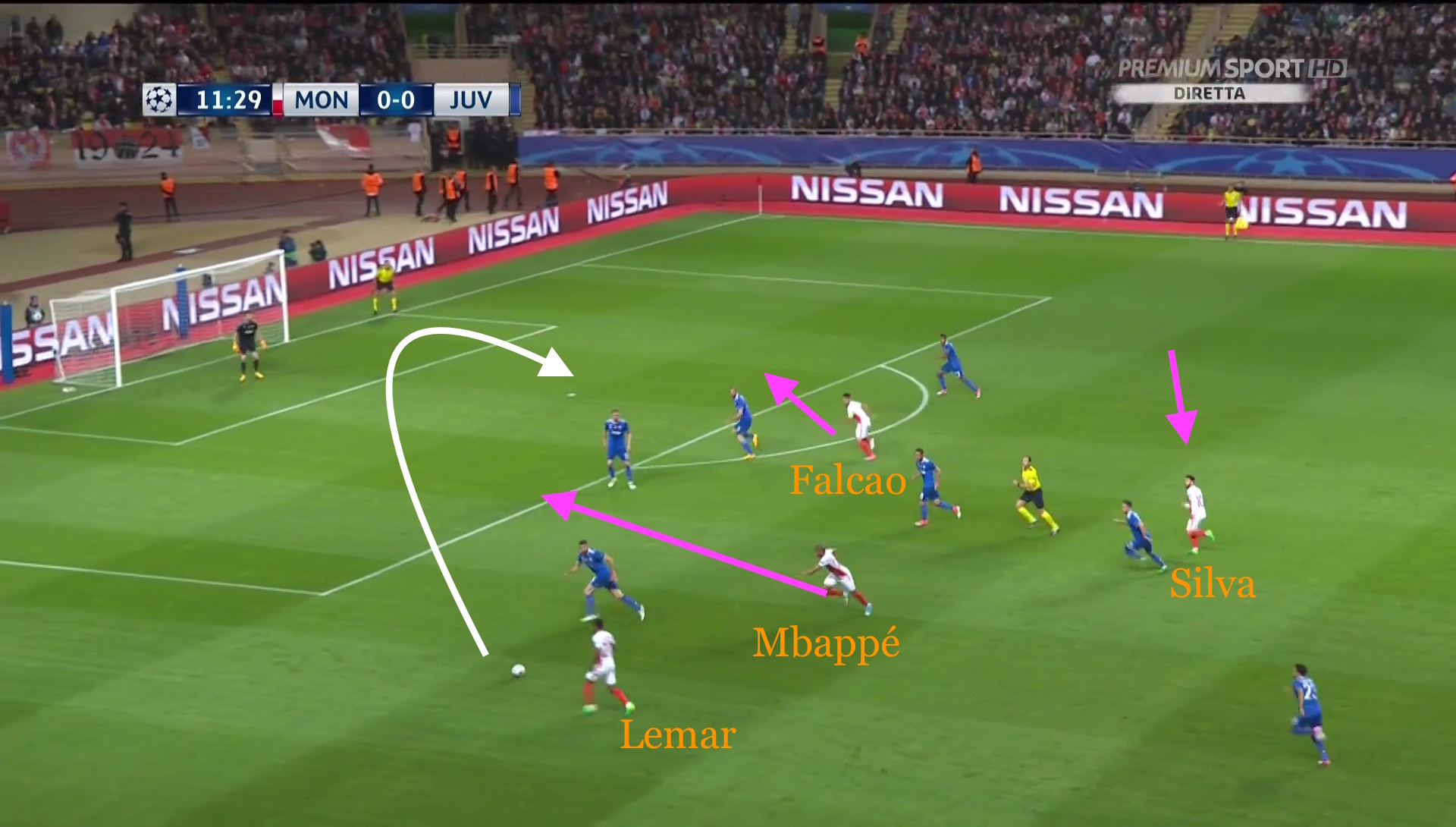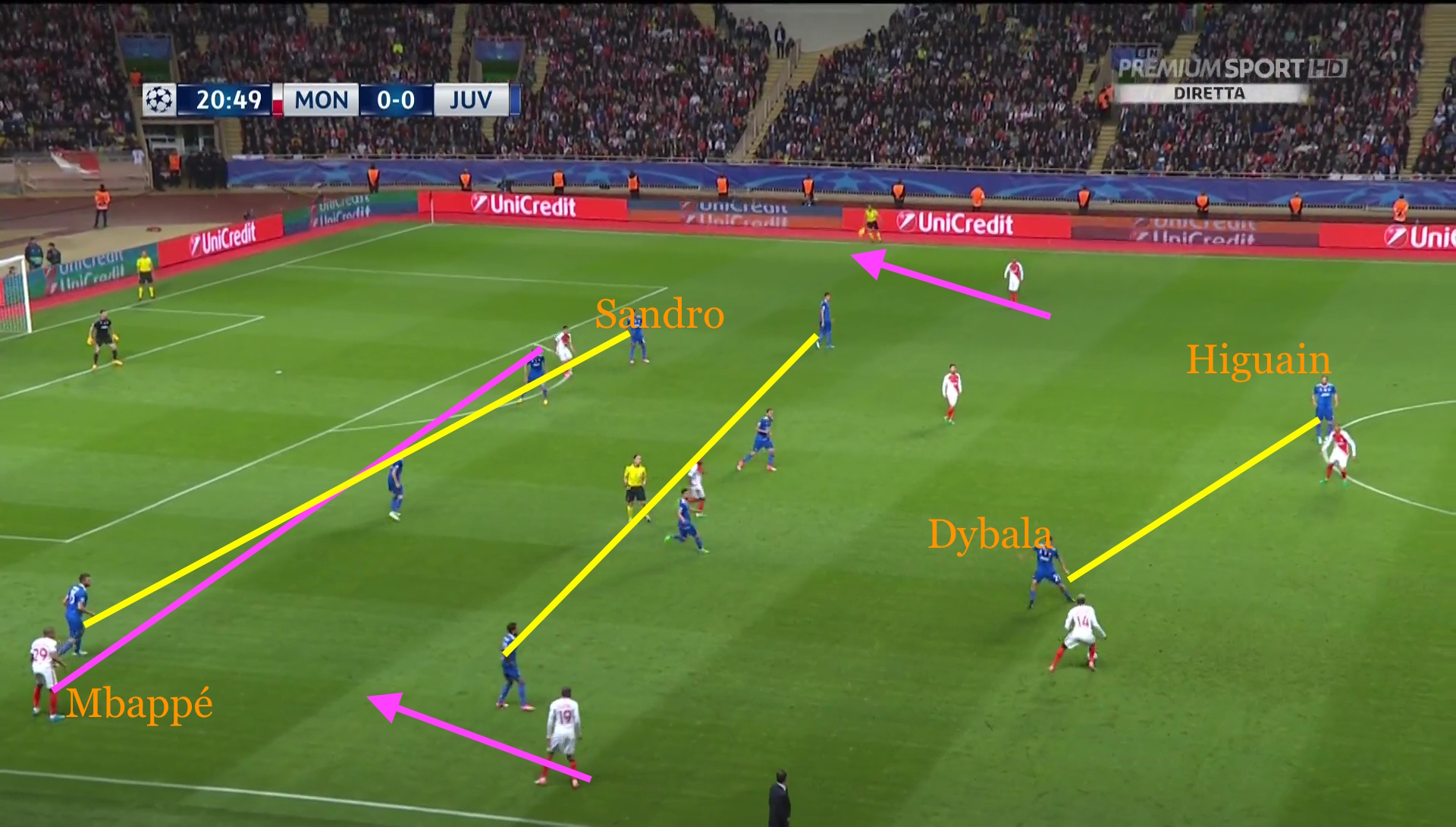Eric Devin writes a detailed tactical analysis of the Champions League semi-final first leg that finished Monaco 0-2 Juventus.
Line-ups
AS Monaco (4-4-2): Danijel Subasic; Nabil Dirar, Kamil Glik, Jemerson, Djibril Sidibé; Bernardo Silva (Almamy Touré 81′), Fabinho, Tiemoué Bakayoko (Joao Moutinho 66′), Thomas Lemar (Valere Germain 67′); Radamel Falcao, Kylian Mbappé
Juventus: (3-5-2): Gianluigi Buffon; Andrea Barzagli, Leonardo Bonucci, Giorgio Chiellini; Dani Alves, Miralem Pjanic (Mario Lemina 89′), Claudio Marchisio (Tómas Rincón 81′), Mario Mandzukic, Alex Sandro; Gonzalo Higuain (Juan Cuadrado 77′), Paulo Dybala
Juventus’ win over Monaco wasn’t wholly unexpected, at least as a result. What was surprising, though, was the efficacy and focus with which the Italian champions operated. Some would have it down to experience, both in terms of the two managers, Leonardo Jardim and Max Allegri and the players, as Juventus’ average age and number of Champions’ League matches in which they had featured dwarfed that of the French side. Others may have had it down to injuries, and Monaco, missing the influential Benjamin Mendy, lacked the balance and width that normally makes them so effective. Finally, there was the matter of individual performances, as Dani Alves and Gianluigi Buffon rolled back the years to lead the way for the Bianconeri, the former assisting both goals and the latter delivering more than a few superb saves.
Those factors all played their part in the result, but more to the point was each side’s tactical execution. The match’s opening stages were fairly even, and even as the match wore on, Monaco didn’t play particularly poorly, but the visitors’ tactical flexibility, particularly that of Mario Mandzukic, began to tell. Monaco, for all their gifts, and being wonderful to watch are somewhat limited, hewing steadfastly to their 4-4-2. Juventus’ subtle wrinkles in different situations left Monaco unable to reply, giving the Italian side the impetus and, with it, the result.
Here we see Monaco’s initial setup, plainly Jardim’s 4-4-2, but a problematic, and poorer version of it. Usually in this system, the fullbacks provide the width, allowing Silva and Lemar to tuck in. This allows Monaco to play with two strikers without one of them forced into coming deep to make up the numbers in midfield. In getting forward, the fullbacks can leave the defense exposed at times, but the central midfielders should theoretically be free to cover their runs. On the night, though, Monaco were often too narrow without the ball, allowing Alex Sandro and Alves entirely too much space.
Juventus’ success isn’t predicated on getting balls into the box for Higuain and Mandzukic to attack, as the two are refined players, despite their “target man” physiques. That said, if Monaco afford their opponents’ wingbacks this much space, it would be foolish for the Italians not to avail themselves of it. Indeed, Alves attempted only three crosses on the evening, but such was the space available to the Brazilian, two of them became assists. Sandro had less space than Alves on the left, but his dribbling ability kept Dirar increasingly pinned back as the evening wore on. Had Mendy been fit, his direct style likely would have limited Alves to a greater degree than Sidibé, but Jardim’s choice of the former Lille man was driven by his attacking abilities rather than his defensive nous.
Juventus had been widely tipped to play a 4-2-3-1, with Juan Cuadrado and Mario Mandzukic flanking Paulo Dybala, but when the teams were announced, the veteran Andrea Barzagli was in the eleven ahead of the Chelsea loanee. Some has thought that Juve might keep that system with Alves being a like-for-like replacement for Cuadrado, but Allegri instead trotted out his BBC, a 3-5-2 in principle. The system had a lot of subtle variations, though; here we can see that it was actually closer to a 3-5-1-1, with Dybala playing a free role behind Higuain, not quite a second striker but neither an attacking midfielder.
On the right, Alves was a fairly orthodox wingback, but on the left, there was considerable variation, as the position map shows. Alex Sandro (12) was nominally the left-sided wingback, but he often cut inside, allowing Mandzukic (17) to move wide to track the runs of Dirar as his pace and endurance made him better equipped to deal with Bernardo Silva. This also allowed Juventus to affect that aforementioned 4-2-3-1 at times, with Sandro playing as an orthodox left back and Alves staying forward, Mandzukic providing the width as the former Porto man played closer to the centre backs.
More importantly than merely playing three at the back, though was the positional flexibility the three centre backs showed. With the ball, as the first image shows, the three played very wide (yellow line), forcing Monaco’s press, i.e. Mbappé to cover more space laterally. The youngster, so effervescent in the match’s early stages, was surely worn out by this, dimming his influence as the match wore on. This spacing, combined with the always sublime passing of Bonucci, allowed the wingbacks to operate as auxiliary attackers, with Pjanic and Marchisio providing “easy” options in central midfield)
When Monaco had the ball, though, Juventus’ defense became much more compact (yellow line), as the second image shows. Sandro tucks into a more central role, while Alves and Mandzukic become the de facto wingbacks, making the system almost a 6-2-2. Packing the box in this manner forced Monaco to play wide, and while Dirar got in a couple decent crosses early on, Sidibé, playing on the “wrong” flank, was next to useless. This also allowed Pjanic and Marchisio to double the dangerous Silva (white arrow), limiting the little Portuguese’s effectiveness to some degree, even as he played a free role cutting inside.
The idea of the bulky Mandzukic playing as a wingback, even against a sometimes-reticent Dirar would seem laughable on the surface, as the bulky Croatian is more of a target man than a fleet-footed wide player. However, those who would dun his chances of success in this role don’t give the veteran enough credit, as his versatility was the single most influential factor in Juventus’ flexibility on the evening, as these three images show.
The first shows Bonucci, playing wide on the left playing the ball over the top to Mandzukic, who exploits the space between Glik and Dirar. Juve’s formation looks more like a 3-2-3-2, at this point, with Alves and Sandro providing the width. Lumping the ball to the big man may seem an unoriginal approach, but Mandzukic’s willingness to win headers for Higuain made it a genuine threat, and also forced Sidibé and Dirar to play slightly deeper and more narrowly to guard against it.
The second image shows Juventus’ “default” setting, the aforementioned 3-5-1-1, with Dybala off Higuain. Here, Mandzukic plays as a central midfielder, alongside Pjanic with Marchisio taking a deeper, more defensive role. Again, Sandro and Alves provide the width, and now, instead of banging in crosses or playing long balls for Mandzukic to chase, Juventus can play the ball through the middle, drawing on the passing range and dribbling abilities of Pjanic and Dybala. This, in turn, forces Lemar and Silva to stay narrow defensively, seen here as the nominal left winger is almost in the centre circle as he marks Pjanic.
The final image shows Mandzukic playing as a wingback, tracking Dirar’s forward run as Sandro tucks inside. This allows Juventus to have a significant numerical advantage (7-4) in the box without sacrificing their width in defense. If Sidibé were a more orthodox left back, this would’ve been less successful, but as it was, the French international played both narrow and deep, allowing Alves to stay in the penalty area. Thus, Mandzukic’s ability to play what was effectively three different positions depending on the situation allowed Juventus to cope with Monaco’s attack with relative ease.
The hosts’ tactics didn’t exactly help themselves, though. As previously mentioned, Silva and Lemar have become accustomed to tucking inside, allowing the fullbacks to provide the width, but when they were reticent to do so, as they often were on the evening, Monaco’s attack looked too often like the first image. Here, the hosts are on the break, with Lemar running at Barzagli, but because the winger has no support from Sidibé, his option for playing a one-two, either to cut inside, or to pull wide, is Mbappé. This pulls the youngster away from the penalty area, diminishing his threat as a goalscorer, while also essentially making a cross for Falcao (white arrow), splitting the defense, his only option, as Silva has also stayed narrow.
When Dirar and Sidibé did get forward, in the second image, Juventus tracked back well as a team. Here, the aforementioned 3-5-1-1 becomes a 4-4-1-1 (yellow lines), with Dybala and Higuain having dropped to press Bakayoko and Fabinho. Thus, even as Dirar and Sidibé (pink arrows) find themselves in space, the visitors literally have ten men behind the ball, leaving no meaningful advantage for Monaco. Here, too, Mbappé has peeled wide to try to get himself one-on-one with Barzagli, but in doing so, he is not only far from Falcao (pink line) but also from the penalty area. Too, were Mbappé to beat Barzagli, as Sandro has tucked in to mark Falcao, Bonucci is still free to come to deal with the youngster.
As the match wore on, the influence of Dirar, who had been key to much of Monaco’s attacking play in the first half, continued to wane. Here, he is walking, minded by Mandzukic, when a switch of play could prove dangerous. Instead, though, Monaco fail to recognize the opportunity, as Silva (pink arrow) similarly moves toward the ball. As it has in many of their recent European matches, Monaco’s endurance and drive, seemingly sapped by a staggering number of matches, a lack of depth and a long season had all but disappeared.
Jardim tried his luck with some changes, as this second image shows, but the results were no better. Here, we can see how the introductions of Joao Moutinho and Valere Germain shaped the side, but also how they made little difference. After their introductions, Moutinho partnered Fabinho in midfield, while Germain played off Falcao, with Mbappé taking Lemar’s place on the wing. Given that width was the issue for Monaco, and that neither of the two substitutes can offer that in any meaningful way, Jardim’s changes did little to affect the match.
One might wonder again how a healthy Benjamin Mendy might have improved Monaco’s lot, given how influential he had been against Tottenham, Manchester City and Dortmund, but odds are, even if Monaco had started on the front foot with the left back in the side, Juventus’ adaptations and different looks would have left the hosts flummoxed. It’s not impossible that Monaco could come back into the tie at the J Stadium next week, but it is unlikely, as Allegri is almost certainly already hard at work on another multivalent plan to frustrate his opponents.
Read all our tactical analyses here




































































